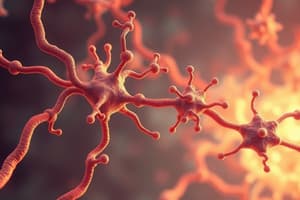Podcast
Questions and Answers
What is a receptor? What are their characteristics?
What is a receptor? What are their characteristics?
Receptor is a class of cellular macromolecules that are concerned specifically and directly with chemical signalling.
- They are finite; thus they should be saturable under high concentrations
- They should display stereoselectivity i.e. recognise only one of the naturally occurring isomers of a ligand. (R/S or D/L)
What are the four structural classifications of receptors?
What are the four structural classifications of receptors?
1)Ligand gated ion-channel receptors 2) G protein-coupled receptors 3) Kinase linked receptors 4) Nuclear receptors
What is a drug target?
What is a drug target?
It is a class of cellular macromolecules that drugs can bind to and mediate chemical signalling. These include receptors, ion channels, enzymes and transport proteins.
Define a ligand
Define a ligand
What is affinity?
What is affinity?
What is a drug?
What is a drug?
What is an agonist?
What is an agonist?
What is efficacy in terms of drug action?
What is efficacy in terms of drug action?
What is affinity in terms of drug action?
What is affinity in terms of drug action?
What is an antagonist?
What is an antagonist?
What is selectivity?
What is selectivity?
What is the relationship between association and dissociation at equilibrium?
What is the relationship between association and dissociation at equilibrium?
What is the Hill Langmuir equation?
What is the Hill Langmuir equation?
What is KA? What is the relationship between KA and affinity of ligand for the receptor?
What is KA? What is the relationship between KA and affinity of ligand for the receptor?
What is pR?
What is pR?
What is pAR?
What is pAR?
What is the relationship between agonist binding and receptor activation?
What is the relationship between agonist binding and receptor activation?
What is IC50?
What is IC50?
What is the two state model in receptor theory?
What is the two state model in receptor theory?
What is drug potency?
What is drug potency?
What are the factors that drug potency is dependant on?
What are the factors that drug potency is dependant on?
Give an example of a relationship between potency and selectivity. Also describe why one drug would be preferred over another in that case.
Give an example of a relationship between potency and selectivity. Also describe why one drug would be preferred over another in that case.
What is a partial agonist?
What is a partial agonist?
What is the difference between full and partial agonist in the mechanisms?
What is the difference between full and partial agonist in the mechanisms?
How do partial agonists such as pindolol act on beta 1 adrenoreceptors?
How do partial agonists such as pindolol act on beta 1 adrenoreceptors?
How do beta blockers like pindolol work on beta 2 adrenoreceptors?
How do beta blockers like pindolol work on beta 2 adrenoreceptors?
What is the difference between Beta 1 and beta 2 adrenergic receptors?
What is the difference between Beta 1 and beta 2 adrenergic receptors?
What is the mechanism of reversible competitive antagonism?
What is the mechanism of reversible competitive antagonism?
What is the mechanism of non-competitive antagonism?
What is the mechanism of non-competitive antagonism?
What is irreversible competitive antagonism?
What is irreversible competitive antagonism?
What are some forms of antagonism not involving the receptor?
What are some forms of antagonism not involving the receptor?
What is chemical antagonism?
What is chemical antagonism?
What is physiological antagonism?
What is physiological antagonism?
What is pharmacokinetic antagonism?
What is pharmacokinetic antagonism?
Flashcards are hidden until you start studying




